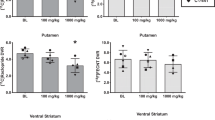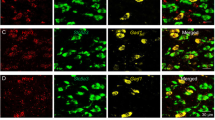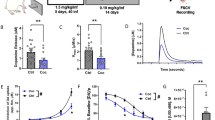Abstract
Using in vivo single-unit recording in rats, we compared the effects of continuous cocaine infusion via minipump or single daily injections (both 40 mg/kg/d × 14 days, SC) on the activity of putative dopamine (DA) neurons in the substantia nigra pars compacta (SNC) and ventral tegmental area (VTA). On days 1–5 after cocaine withdrawal, animals were further treated with single daily injections of DA agonists. On withdrawal day 7 continuous cocaine caused a reduction in spontaneously active neurons in the SNC and reduced bursting in the VTA. In contrast, intermittent cocaine resulted in an increase in the number of active neurons in the VTA. These changes were all reversed by apomorphine or quinpirole given during the first 5 withdrawal days. The D1 antagonist SCH 39166 did not antagonize the effects of apomorphine in either region. The role of D2 receptors in modulating baseline DA activity during intermediate cocaine withdrawal is discussed.
Similar content being viewed by others
Log in or create a free account to read this content
Gain free access to this article, as well as selected content from this journal and more on nature.com
or
References
Ackerman JM, White FJ . (1992): Decreased activity of rat A10 dopamine neurons following withdrawal from repeated cocaine. Eur J Pharmacol 218: 171–173
Bunney BS, Aghajanian GK, Roth RH . (1973): Comparison of effects of L-DOPA, amphetamine and apomorphine on firing rate of rat dopaminergic neurons. Nature 245: 123–125
Bunney BS, Grace AA . (1978): Acute and chronic haloperidol treatment: Comparison of effects on nigral dopaminergic cell activity. Life Sci 23: 1715–1727
Cameron DL, Williams JT . (1993): Dopamine D1 receptors facilitate transmitter release. Nature 366: 344–347
Charlety PJ, Grenhoff J, Chergui K, De la Chapelle B, Buda M, Svensson TH, Chouvet G . (1991): Burst firing of mesencephalic dopamine neurons is inhibited by somatodendritic application of kynurenate. Acta Phys Scand 142: 105–112
Chiodo LA, Bunney BS . (1983): Typical and atypical neuroleptics: Differential effects of chronic administration on the activity of A9 and A10 midbrain dopaminergic neurons. J Neurosci 3: 1607–1619
Dai M, Tepper JM . (1998): Do silent dopaminergic neurons exist in rat substantia nigra in vivo? Neuroscience 85: 1089–1099
Ellinwood EH Jr, Lee TH . (1983): Effect of continuous systematic infusion of d-amphetamine on the sensitivity of nigral dopamine cells to apomorphine inhibition of firing rate. Brain Res 273: 379–383
Gallager DW, Pert A, Bunney WE Jr . (1978): Haloperidol-induced presynaptic dopamine supersensitivity is blocked by chronic lithium. Nature 273: 309–312
Gao WY, Lee TH, King GR, Ellinwood EH . (1998): Alterations in baseline activity and quinpirole sensitivity in putative dopamine neurons in the substantia nigra and ventral tegmental area after withdrawal from cocaine pretreatment. Neuropsychopharmacology 18: 222–232
Gariano RF, Groves PM . (1988): Burst firing induced in midbrain dopamine neurons by stimulation of the medial prefrontal and anterior cingulate cortices. Brain Res 462: 194–198
Gawin FH, Ellinwood EH Jr . (1988): Cocaine and other stimulants: Actions, abuse and treatments. N Engl J Med 318: 1173–1182
Gawin FH, Khalsa H, Ellinwood EH Jr . (1994): Stimulants. In Galanter M, Kleber HD (eds), Textbook of Substance Abuse. Washington, D.C., American Psychiatric Press, pp 111–139
Giannini AJ, Folts DJ, Feather JN, Sullivan BS . (1989): Bromocriptine and amantadine in cocaine detoxification. Psychiatry Res 29: 11–16
Gold MS, Miller S, Jonas JN . (1992): Cocaine (and crack): Neurobiology. In Lowinson JH, Ruiz P, Millman RB, Langrod JG (eds), Substance Abuse: A Comprehensive Textbook. Baltimore, MD, Williams and Wilkins, pp 222–235
Gonon FG . (1988): Nonlinear relationship between impulse flow and dopamine released by rat midbrain dopaminergic neurons as studied by in vivo electrochemistry. Neuroscience 24: 19–28
Grace AA, Bunney BS . (1984): The control of firing pattern in nigra dopamine neurons: Burst firing. J Neurosci 4: 2877–2890
Henry DJ, Greene MA, White FJ . (1989): Electrophysiological effect of cocaine in the mesoaccumbens dopamine system: Repeated administration. J Pharmacol Exp Ther 251: 833–839
Inada T, Polk K, Purser C, Hume A, Hoskins B, Ho IK, Rockhold RW . (1992): Behavioral and neurochemical effects of continuous infusion of cocaine in rats. Neuropharmacology 31: 701–708
Jeziorski M, White FJ . (1989): Dopamine agonists at repeated “autoreceptor selective” doses: Effects upon the sensitivity of A10 dopamine neurons. Synapse 4: 267–280
Joyner C, King GR, Lee TH, Ellinwood EH Jr . (1993): A technique for the continuous infusion of high doses of cocaine by osmotic minipump. Pharmacol Biochem Behav 44: 971–973
Kalivas PW . (1995): Neural basis of behavioral sensitization to cocaine. In Hammer RP Jr (ed), The Neurobiology of Cocaine: Cellular and Molecular Mechanisms. Boca Raton, FL, CRC Press, pp 81–98
Kalivas PW, Duffy P . (1998): Repeated cocaine administration alters extracellular glutamate in the ventral tegmental area. J Neurochem 70: 1497–1502
Kamata K, Rebec GV . (1984): Nigral dopaminergic neurons: Differential sensitivity to apomorphine following long-term treatment with low and high doses of amphetamine. Brain Res 321: 147–150
Kilbey MM, Ellinwood EH Jr . (1977): Administration of stimulant drugs: Response modification. In Ellinwood EH Jr, Kilbey MM (eds), Advances in Behavioral Biology: Cocaine and Other Stimulants. New York, Plenum Press, pp 409–429
King GR, Joyner C, Lee TH, Kuhn C, Ellinwood EH Jr . (1992): Intermittent and continuous cocaine administration: Residual behavioral states during withdrawal. Pharmacol Biochem Behav 43: 243–248
Kleber HD . (1995): Pharmacology, current and potential for the treatment of cocaine dependence. Clin Neuropharmacol 18[Suppl 1]:s96–s109
Kramer JC, Fischman VS, Littlefield DC . (1967): Amphetamine abuse: Pattern and effects of high doses taken intravenously. JAMA 201: 305
Lau CE, Imam A, Fang M, Falk JL . (1991): Acute effects of cocaine on spontaneous and discriminative motor functions: Relation to route of administration and pharmacokinetics. J Pharmacol Exper Ther 257: 444–456
Lee TH, Ellinwood EH Jr . (1989): Time-dependent changes in the sensitivity of dopamine neurons to low doses of apomorphine following amphetamine infusion. Brain Res 483: 17–29
Lee TH, Ellinwood EH, Zhang H . (1993): In vitro extracellular recording from nigra dopamine neurons following continuous d-amphetamine infusion. Eur J Pharmacol 232: 125–129
Lee TH, Gao W-Y, Ellinwood EH . (1997): Differential effects of SCH 23390 on the apomorphine subsensitivity in the substantia nigra and ventral tegmental area 1 day following withdrawal from continuous or intermittent cocaine pretreatment. Brain Res 744: 293–301
Lee TH, Gee KR, Ellinwood EH, Seidler FJ . (1998): Altered cocaine potency in the nucleus accumbens following 7 day withdrawal from intermittent but not continuous treatment: Voltammetric assessment of dopamine uptake in the rat. Psychopharmacology 137: 303–310
Mendrek A, Blaha CD, Phillips AG . (1998): Pre-exposure of rats to amphetamine sensitizes self-administration of this drug under a progressive ratio schedule. Psychopharmacology 135: 416–422
Mereu G, Hu X-T, Wang RY, Westfall TC, Gessa GL . (1987): Failure of subchronic lisuride to modify A10 dopamine autoreceptor's sensitivity. Brain Res 408: 210–214
Nickolson VJ . (1981): Detailed analysis of the effects of apomorphine and d-amphetamine on spontaneous locomotor behaviour in rats as measured in a TV-based, automated open-field system. Eur J Pharm 72: 45–56
Overton PG, Clark D . (1997): Burst firing in midbrain dopaminergic neurons. Brain Res Rev 25: 312–334
Paxinos G, Watson C . (1986): The Rat Brain in Stereotaxic Coordinates, 2nd ed. San Diego, Academic Press
Pitts DK, Freeman AS, Kelland MD, Chiodo LA . (1989): Repeated amphetamine, reduced dopamine neuronal responsiveness to apomorphine but not quinpirole. Eur J Pharmacol 162: 167–171
Pitts DK, Kelland MD, Freeman AS, Chiodo LA . (1993): Repeated amphetamine administration: Role of forebrain in reduced responsiveness of nigrostriatal dopamine neurons to dopamine agonists. J Pharmacol Exp Ther 264: 616–621
Post RM, Contel NR . (1983): Human and animal studies of cocaine: Implications for development of behavioral pathology. In Creese I (ed), Stimulants: Neurochemical, Behavioral, and Clinical Perspectives. New York, Raven Press, pp 169–203
Post RM, Rose H . (1976): Increasing effects of repetitive cocaine administration in the rat. Nature 260: 731–732
Reith MEA, Benuck M, Lajtha A . (1987): Cocaine disposition in the brain after continuous or intermittent treatment and locomotor stimulation in mice. J Pharmacol Exp Ther 243: 281–287
Robinson TE, Berridge KC . (1993): The neural basis of drug craving: An incentive-sensitization theory of addiction. Brain Res Rev 18: 247–291
Self DW, Barnhart WJ, Lehman DA, Nestler EJ . (1996): Opposite modulation of cocaine-seeking behavior by D1- and D2-like dopamine receptor agonists. Science 271: 1586–1589
Skirboll LR, Grace AA, Bunney BS . (1979): Dopamine auto- and postsynaptic receptors: Electrophysiological evidence for differential sensitivity to dopamine agonists. Science 206: 80–82
Svensson TH, Tung C-S . (1989): Local cooling of prefrontal cortex induces pacemaker-like firing of dopamine neurons in rat ventral tegmental area in vivo. Acta Physiol Scand 136: 135–136
Weiss F, Parsons LH, Markou A . (1995): Neurochemistry of cocaine withdrawal. In Hammer RP Jr (ed), The Neurobiology of Cocaine: Cellular and Molecular Mechanisms. Boca Raton, FL, CRC Press, pp 163–181
White FJ, Hu X-T, Henry DJ, Zhang X-F . (1995): Neurophysiological alterations in the mesocorticolimbic dopamine system with repeated cocaine administration. In Hammer RP Jr (ed), The Neurobiology of Cocaine: Cellular and Molecular Mechanisms. Boca Raton, FL, CRC Press, pp 99–119
Zhang H, Lee TH, Ellinwood EH Jr . (1992): The progressive changes of neuronal activities of the nigral dopaminergic neurons upon withdrawal from continuous infusion of cocaine. Brain Res 594: 315–318
Acknowledgements
Supported by National Institute on Drug Abuse (DA-06519 to THL and DA-10327 to EHE) and Duke Small Grant Program. We thank Dr. Allen Barnett for a gift of SCH 39166 and Zhiping Xiong and Scott Douglas for technical assistance.
Author information
Authors and Affiliations
Corresponding author
Rights and permissions
About this article
Cite this article
Lee, T., Gao, WY., Davidson, C. et al. Altered Activity of Midbrain Dopamine Neurons Following 7-Day Withdrawal from Chronic Cocaine Abuse is Normalized by D2 Receptor Stimulation During the Early Withdrawal Phase. Neuropsychopharmacol 21, 127–136 (1999). https://doi.org/10.1016/S0893-133X(99)00011-1
Received:
Revised:
Accepted:
Issue date:
DOI: https://doi.org/10.1016/S0893-133X(99)00011-1
Keywords
This article is cited by
-
Dopamine and addiction: what have we learned from 40 years of research
Journal of Neural Transmission (2019)
-
Animal models and treatments for addiction and depression co-morbidity
Neurotoxicity Research (2007)



